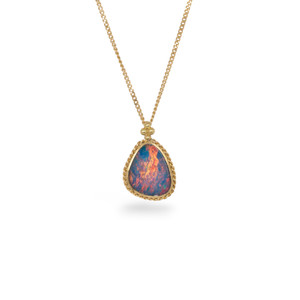
Ethiopian Opal Necklace
by Amali
 Includes
FREE Shipping*
Includes
FREE Shipping*
For Amáli, the gemstone comes first. Their settings are individually handmade- never cast- so they can custom fit each setting to its stone, building a one-of-a-kind artwork around each special gem.
This 3.45ct cabochan Ethiopian opal makes up this lovely pendant, set in a handmade 18K yellow gold braided bezel and beaded detail, complete with a satin finish.
Amáli designs their custom metal setting to cradle and complement each individual gemstone, hand-shaping a gold bezel around its unique shape and adding textile-style embellishments one chain link at a time. Their design and attention to detail are reminiscent of the Etruscan style, with the braided detail and gold granulated prongs.
Ethiopian Opal is known for its dreamy, delicate, shimmering brightness. Opal’s mesmerizing play of color is what happens when tiny, stacked silica spheres diffract light. Amáli loves designing Ethiopian Opal rings, earrings and necklaces that highlight and enhance the natural beauty of this gemstone.
What is the difference in Australian and Ethiopian Opals?
Although Australian and Ethiopian Opals can look very similar, there is one important difference. Australian Opals are mined deep within the Earth’s crust, while Ethiopian Opals are found up on hillsides in volcanic deposits. They both have the typical silica sphere structure but are influenced by their surroundings.
Ethiopian Opal is known as a Hydrophane Opal, meaning it can absorb and dry up water. Since Australian Opal carries significantly less water, it is more durable than Ethiopian Opal.
Both of these are in the Jelly Opal family. Jelly Opals have a more translucent “backdrop”, meaning the colors at play are bouncing off of an almost clear stone. In most Australian and Ethiopian Opals, you’ll often see shades of blue–from cerulean to indigo. But like other Opals, the color possibilities are endless!
How to care for your Opals:
With any opals, avoid exposure to harsh chemicals. This can be anything from perfume to sunscreen. Liquids like perfumes, soaps, and cleaning products can stain your Opals, which will also result in a change in color.
Ethiopian Opals are "hydrophane", which makes them thirsty for water. If they come in contact with water, they will absorb it like a sponge. Absorbing too much water may result in unwanted changes to your Opals.
If Opals are left in water and allowed to soak it up, they may lose their fire temporarily and turn yellow or brown. Don't worry, the fire and color will come back once the Opals have fully dried, which can take a few minutes to weeks, depending on how much water they managed to absorb.
When drying an Opal that has soaked up water, let it dry naturally. Ethiopian Opals should only be exposed to gradual temperature changes. Do not try to speed up the process by placing the Opals under a hot light or hair dryer.
This is why your Ethiopian Opal jewelry should be the last thing you put on when you get ready, and the first thing you remove when you get home. You’ll want to store it in its own cloth bag or box away from other gemstones.
NOT AN EVERYDAY PIECE!
| Metal: | 18K Yellow Gold | Gemstone: | 3.45ct Cabochan Ethiopian Opal | Gemstone Size: | 12x10mm | Length: | 16-18" | Clasp Type: | Lobster Clasp | : |


















